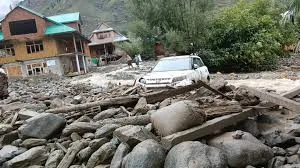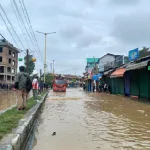Just two days of relentless rain have been enough to push the Jhelum River to its edge, triggering flooding in low-lying areas of Srinagar and reviving the trauma of the devastating 2014 deluge. From Rajbagh to Kursoo, Bemina to Pampore, residents watched water creep into their homes, lanes, and memories, leaving behind fear, frustration, and questions that remain unanswered 11 years on.
“It felt like déjà vu,” said Zahida Bano of Rajbagh, whose lane was submerged within hours. “The same panic, the same fear, only this time, we thought lessons had been learned.”
“We cannot sleep when it rains now,” said Ghulam Nabi Dar, a shopkeeper in Pampore who lost his home in 2014. “The roar of the Jhelum is terrifying.”
In Kursoo and Rajbagh, boats became lifelines once again. Streets turned into streams as residents scrambled to upper floors with essentials, while others struggled to evacuate elderly family members or chronically ill patients. One local, Riyan Wani, described carrying his unwell mother through floodwater. “The water reached our ground floor by noon. And no one had warned us,” he said.
The State Disaster Response Force (SDRF) deployed boats, and the Irrigation and Flood Control (I&FC) Department claimed to have placed over one lakh sandbags across vulnerable points along the Jhelum. Seventeen high-risk locations have been identified, officials said, and SDRF teams are on standby for evacuation.
“We are monitoring all 17 vulnerable spots. While the situation is not yet critical, we are prepared with boats and sandbags,” an I&FC engineer told Rising Kashmir.
Yet residents were not reassured. “There’s a 300-meter distance from Jhelum to this locality, yet water enters our homes first,” said Riyaz Ahmed in Kursoo. “If dredging was really done, why is it flooding again? This proves the government’s measures are cosmetic.”
Experts, however, warn that the Valley needs more than short-term firefighting. “The Jhelum’s carrying capacity has shrunk drastically. Dredging and widening projects remain stalled, while encroachments on floodplains continue. Without structural changes, Kashmir will always remain vulnerable,” observed a hydrologist at Kashmir University
Forecasting infrastructure set up in Sangam, Ram Munshi Bagh, and Safpora has been diverted from hydrological warnings to trans-boundary water monitoring. No early-warning system currently alerts residents or triggers evacuation protocols in time.
“We do not want to relive September 2014,” said Abdul Hameed, a farmer in Pampore. “That flood scarred our lives forever.”
As communication lines snapped due to heavy rains, the Valley faced a 24-hour internet and phone blackout. With digital payments stalled, ATMs down, and access to emergency services affected, the situation grew more chaotic.
“I couldn’t buy medicine because UPI was down,” said Abdul Majid in Hyderpora. “Even ATMs weren’t working.”
Local businesses also suffered. “We rely on digital payments. Every hour offline hurts us,” said Fayaz Lone, a shopkeeper.
A decade after the 2014 disaster submerged nearly 400 villages and large parts of Srinagar, the scars remain, etched in memory, in rebuilt homes, and now in the rising waters of Jhelum.
Urban planners and environmentalists say the approach must now move beyond crisis-response to long-term flood resilience.
“Walls and dredging alone won’t save Srinagar,” said an environmental activist. “We need flood zoning, wetland revival, a secondary spill channel, forecasting, and real institutional readiness.”
Despite crores spent, multiple plans launched, and countless committee meetings, residents still flee floodwaters at the first sign of rain.
The Valley has moved from emergency to exhaustion, and experts warn: unless structural reforms begin now, the next disaster might not just echo the past, it could be far worse.






